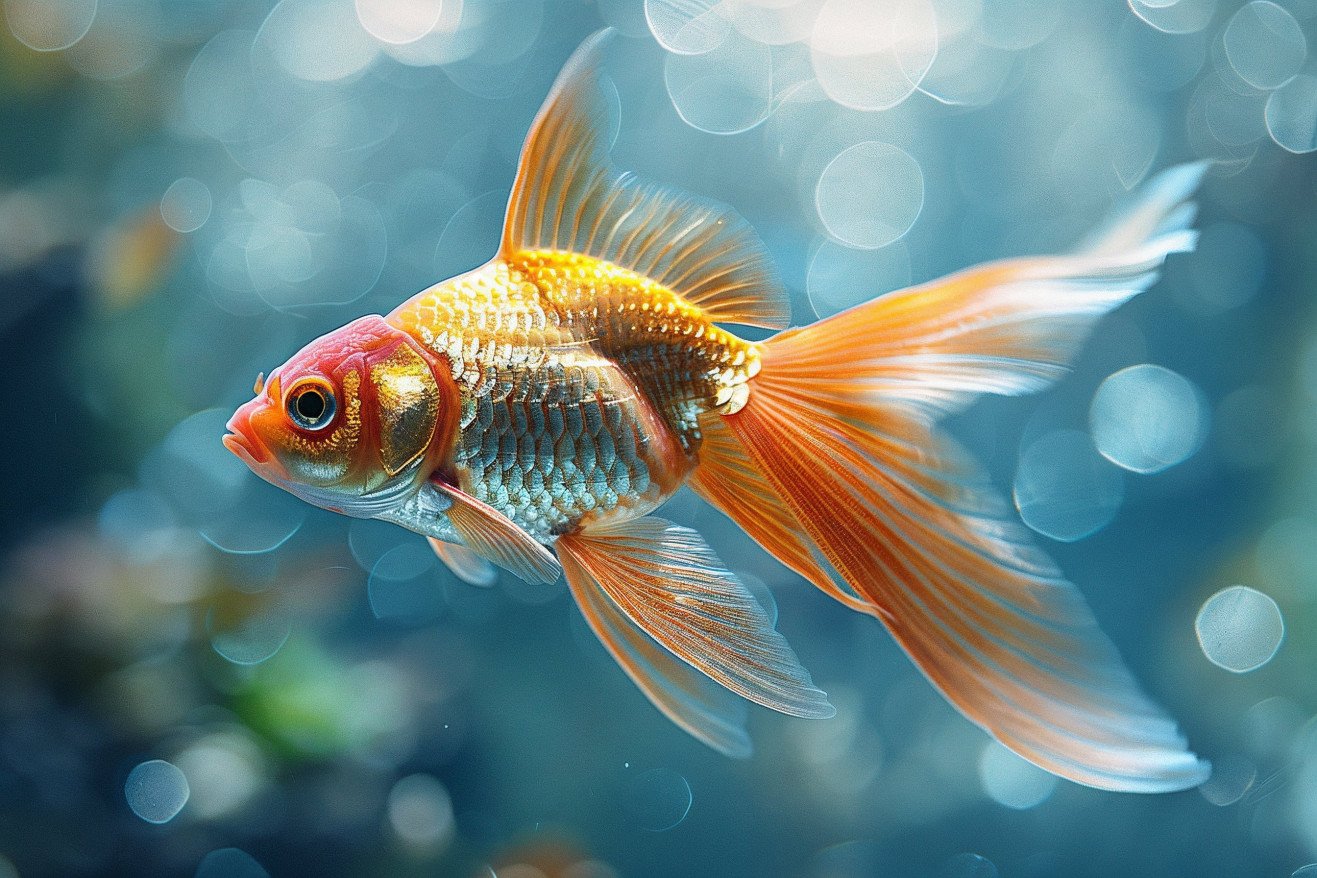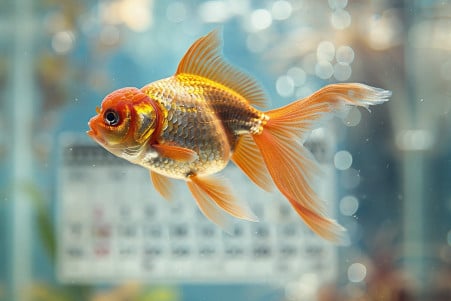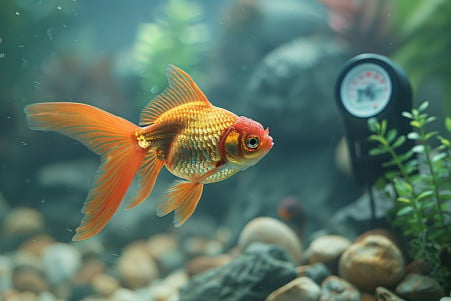Are Goldfish Healthy? An In-Depth Look
4 May 2024 • Updated 2 May 2024

Goldfish are known for being hardy fish, especially if they're kept in the right environment and given the right care. That said, they are susceptible to a number of health issues, including swim bladder disorder, white spot disease, fin rot, and more, if their water quality isn't maintained or if they become stressed. If their needs are met, including a healthy diet and clean water, goldfish can live for more than 20 years.
We'll be using evidence from veterinary medicine, ichthyology, and the aquarium hobbyist community to determine if goldfish can be considered a healthy pet. This information will help you decide if you can provide the care and environment goldfish need to thrive, and if you should consider goldfish as a pet in the first place.
Are Goldfish Healthy?
How to Tell If Your Goldfish Is Happy
According to Your Aquarium, a goldfish that is swimming constantly and exploring all areas of the tank is a happy and healthy goldfish. Other signs of a healthy goldfish include eating regularly and swimming up to the top of the tank when it's time to eat, according to Aqua-Tech.
Healthy goldfish will also have bright colors, shiny scales, gills that move in and out regularly and at a normal pace, and no white spots or tattered fins, according to Cuteness and Aqua-Tech. Signs of an unhealthy goldfish include lethargy, loss of appetite, swimming erratically, pale or dark color, rapid breathing, hiding, and aggression toward other fish, according to BeChewy.
It is important to keep an eye on your goldfish for these signs so that you can catch any health issues early. This way, you can address them before they become serious. By paying close attention, you can make sure your goldfish is healthy and happy in its environment.
Signs and Symptoms of Common Goldfish Health Problems
While goldfish are known for being hardy, they can still be affected by a number of health issues. 7 Common Goldfish Diseases: Are Your Goldfish Sick? explains that poor water quality, stress, and not quarantining new fish are some of the most common reasons that goldfish get sick.
Signs of illness may include gasping for air, refusing to eat, swimming erratically, being lethargic, and physical changes like clamped fins or a change in color, per Goldfish Disease Symptoms: 14 Early Signs that Your Goldfish Are Sick. Some of the most common goldfish diseases are white spot disease, fin rot, fungal infections, buoyancy problems, and parasites like anchor worms or fish lice, according to Common Goldfish Diseases & Illnesses (And Treatments).
If you catch these diseases early and treat them quickly while also making sure to improve water quality, you can help your goldfish recover. By learning about these potential issues and keeping an eye out for them, goldfish owners can make sure that their fish stay happy and healthy.
Tank Size and Stocking Levels for Healthy Goldfish
Goldfish need much larger tanks than most people realize, especially as they get bigger. According to The Goldfish Tank, common goldfish should be kept in a minimum 30-gallon tank with an additional 12 gallons for each additional fish. Meanwhile, fancy goldfish should be kept in a minimum 20-gallon tank with an additional 10 gallons for each additional fish.
Overstocking and keeping goldfish in small tanks will result in poor water quality, stress, and health problems for the fish. As explained by FishLab, a good general rule is to aim for a 10-gallon tank for one goldfish and a 20-gallon tank for two goldfish. Making sure to give them enough room to swim and calculating the tank size based on the tank's length, width, and depth are important for the health of your goldfish.
The Spruce Pets also notes that goldfish will need larger tanks as they grow, with single-tailed goldfish potentially needing 75 gallons or more for a single fish. It's important to make sure you increase the tank size as your goldfish grows to prevent stunting and other health problems caused by overstocking.
What to Feed Goldfish for the Best Nutrition
Goldfish require certain nutrients to grow and thrive. According to Feeding Goldfish. What do Goldfish Eat? "Get the Answers Here! - Windsor Fish Hatchery Online, a balanced diet for goldfish should include high-quality pellets or flakes that are high in protein and low in fat. Goldfish are omnivores, so they can also benefit from a diet that includes live foods, vegetables, and aquatic plants.
The INJAF suggests avoiding flake food and instead opting for a high-quality sinking pellet. To make the food easier for goldfish to digest, the INJAF also recommends soaking dry food for a few seconds before feeding it to your goldfish. It's also important to feed goldfish on a regular schedule and in small amounts 2-3 times a day to prevent overfeeding.
According to The Spruce Pets, goldfish don't need a diet that's high in protein or fat. Instead, a maintenance diet that contains around 30% protein and less than 8% fat is best. Fiber levels should be no more than 20-30%. Overfeeding can lead to obesity, water quality issues, and the need for larger tanks as goldfish grow at a rapid rate.
By providing a diet that's balanced and rich in nutrients and following best practices when it comes to feeding, goldfish owners can help ensure their pets are as healthy and happy as possible. This kind of nutrition will also help ensure that goldfish are ready for the optimal water quality that's discussed in the next section.
Keeping the Water Clean and Healthy for Goldfish
Goldfish require clean water to stay healthy. Because they produce a lot of waste, it's important to have a good filtration system and to change the water regularly, according to the RSPCA Knowledgebase. Water quality can be assessed based on several factors, including ammonia, nitrite, and nitrate levels, pH, and temperature.
Per The Spruce Pets, goldfish can tolerate some ammonia, nitrite, and nitrate in the water in a closed system. However, nitrate levels should be kept below 20 mg/L, and ammonia and nitrite should be zero once the nitrogen cycle has been established in the tank.
Stress can be minimized by ensuring that the tank is well-aerated, that there are plenty of places for fish to hide, and that the water temperature and quality are consistent, according to BeChewy. Goldfish need a stable environment to stay healthy, and maintaining consistent water quality is key to preventing health problems. By keeping a close eye on the water and making sure that it stays clean and healthy, goldfish owners can help ensure that their pets are happy and well.
Conclusion: Do Goldfish Fit Into Your Life?
Goldfish can be fun, colorful pets for any household and, with the right care and environment, can live a long, healthy life, says PetMD. They are a great first pet for anyone, including children, and can be a wonderful companion for many years.
It’s important to take good care of your goldfish to ensure they live as long as possible and are as happy as possible. Goldfish live an average of 10 to 15 years, and sometimes up to 20 years, when they are well taken care of. Good care can add years to your pet’s life.
According to Advanced Aquarium Concepts, goldfish can be a healthy pet if they are provided with the essentials, including a large tank, good water quality, the right temperature, and a balanced diet. It’s also important to provide the right care and monitor their health.
Petco explains that maintaining good water quality through regular water changes and proper filtration is important for keeping goldfish healthy. It’s also important to make sure they are not kept in overcrowded conditions, which can lead to stress and disease.
By learning about the specific care needs, potential health issues, and optimal living conditions for goldfish, pet owners can make educated decisions about how to care for these beloved pets in a way that is responsible.


